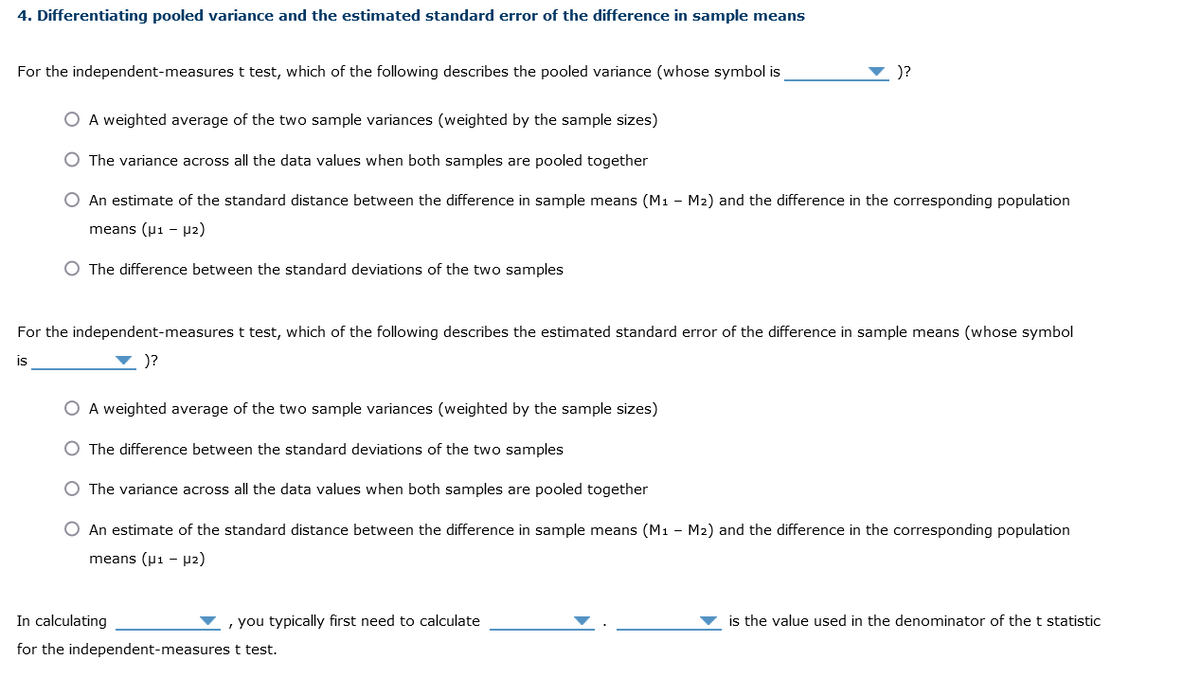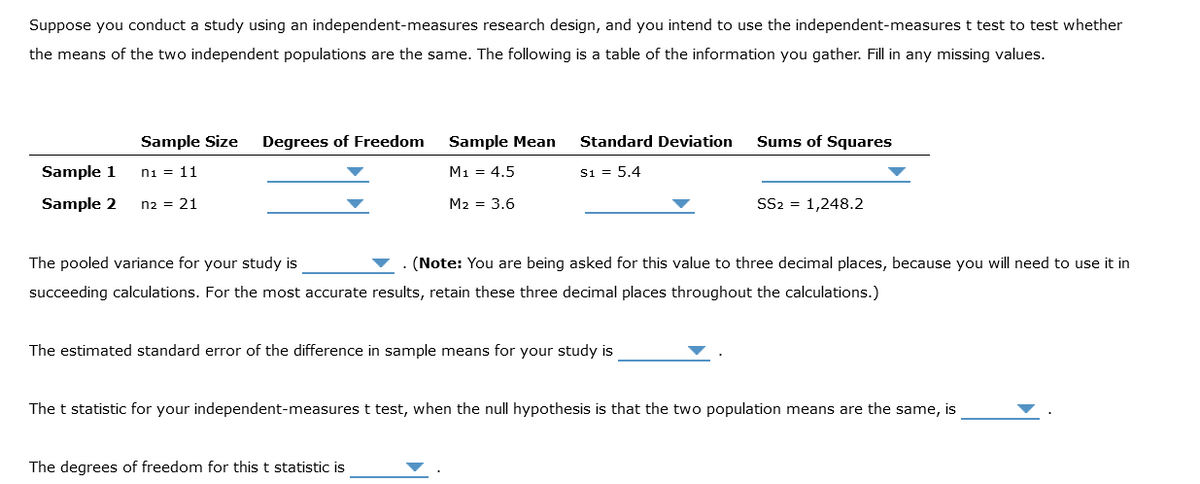4. Differentiating pooled variance and the estimated standard error of the difference in sample means For the independent-measures t test, which of the following describes the pooled variance (whose symbol is )? O A weighted average of the two sample variances (weighted by the sample sizes) O The variance across all the data values when both samples are pooled together O An estimate of the standard distance between the difference in sample means (M1 - M2) and the difference in the corresponding population means (μ1 - µ2) O The difference between the standard deviations of the two samples For the independent-measures t test, which of the following describes the estimated standard error of the difference in sample means (whose symbol ▼ )? is O A weighted average of the two sample variances (weighted by the sample sizes) O The difference between the standard deviations of the two samples
4. Differentiating pooled variance and the estimated standard error of the difference in sample means For the independent-measures t test, which of the following describes the pooled variance (whose symbol is )? O A weighted average of the two sample variances (weighted by the sample sizes) O The variance across all the data values when both samples are pooled together O An estimate of the standard distance between the difference in sample means (M1 - M2) and the difference in the corresponding population means (μ1 - µ2) O The difference between the standard deviations of the two samples For the independent-measures t test, which of the following describes the estimated standard error of the difference in sample means (whose symbol ▼ )? is O A weighted average of the two sample variances (weighted by the sample sizes) O The difference between the standard deviations of the two samples
Glencoe Algebra 1, Student Edition, 9780079039897, 0079039898, 2018
18th Edition
ISBN:9780079039897
Author:Carter
Publisher:Carter
Chapter10: Statistics
Section10.4: Distributions Of Data
Problem 19PFA
Related questions
Question
Answer correctly

Transcribed Image Text:4. Differentiating pooled variance and the estimated standard error of the difference in sample means
For the independent-measures t test, which of the following describes the pooled variance (whose symbol is
O A weighted average of the two sample variances (weighted by the sample sizes)
The variance across all the data values when both samples are pooled together
O An estimate of the standard distance between the difference in sample means (M₁ - M2) and the difference in the corresponding population
means (μ1 µ2)
O The difference between the standard deviations of the two samples
)?
For the independent-measures t test, which of the following describes the estimated standard error of the difference in sample means (whose symbol
)?
is
A weighted average of the two sample variances (weighted by the sample sizes)
The difference between the standard deviations of the two samples
O The variance across all the data values when both samples are pooled together
O An estimate of the standard distance between the difference in sample means (M1 M2) and the difference in the corresponding population
means (μ1 µ₂)
In calculating
for the independent-measures t test.
, you typically first need to calculate
is the value used in the denominator of the t statistic

Transcribed Image Text:Suppose you conduct a study using an independent-measures research design, and you intend to use the independent-measures t test to test whether
the means of the two independent populations are the same. The following is a table of the information you gather. Fill in any missing values.
Sample Size Degrees of Freedom
n1 = 11
Sample 1
Sample 2 n2 = 21
Sample Mean
M₁ = 4.5
M2 = 3.6
Standard Deviation
S1 = 5.4
The estimated standard error of the difference in sample means for your study is
The degrees of freedom for this t statistic is
Sums of Squares
The pooled variance for your study is
(Note: You are being asked for this value to three decimal places, because you will need to use it in
succeeding calculations. For the most accurate results, retain these three decimal places throughout the calculations.)
SS2 = 1,248.2
The t statistic for your independent-measures t test, when the null hypothesis is that the two population means are the same, is
Expert Solution
This question has been solved!
Explore an expertly crafted, step-by-step solution for a thorough understanding of key concepts.
This is a popular solution!
Trending now
This is a popular solution!
Step by step
Solved in 2 steps

Recommended textbooks for you

Glencoe Algebra 1, Student Edition, 9780079039897…
Algebra
ISBN:
9780079039897
Author:
Carter
Publisher:
McGraw Hill

College Algebra (MindTap Course List)
Algebra
ISBN:
9781305652231
Author:
R. David Gustafson, Jeff Hughes
Publisher:
Cengage Learning

Glencoe Algebra 1, Student Edition, 9780079039897…
Algebra
ISBN:
9780079039897
Author:
Carter
Publisher:
McGraw Hill

College Algebra (MindTap Course List)
Algebra
ISBN:
9781305652231
Author:
R. David Gustafson, Jeff Hughes
Publisher:
Cengage Learning